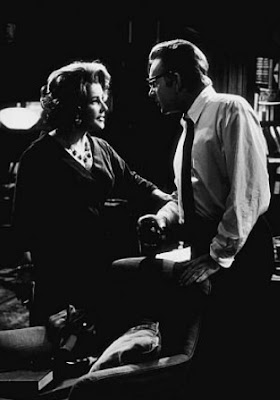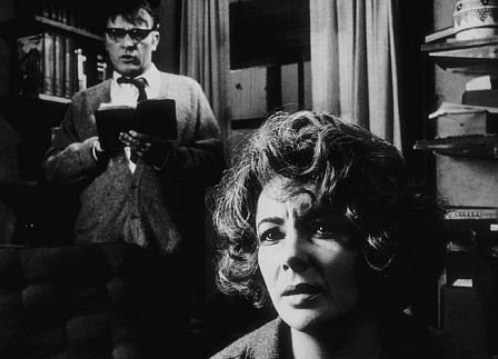Written by Megan Kearns.
When I was young, my mom raised me on classic films: Gone with the Wind, Casablanca, The Great Escape, Breakfast at Tiffany’s. I fondly remember watching Elizabeth Taylor on-screen. Hollywood royalty, we often think of her arresting beauty, numerous marriages, struggle with alcohol, philanthropy and perfume commercials. It’s easy to forget she was an amazing actor; a stellar artist who fluidly exuded strength, sensuality, vitality, passion and pain.Starring in over 50 films, Taylor often chose feminist roles. In National Velvet, she plays a young girl disguising herself as a male jockey to compete. In Cat on a Hot Tin Roof, she’s a fiery survivor embracing her sexuality. And in the Texas saga Giant, she plays an educated and outspoken woman, challenging sexism. So after years of my mother urging me, I finally watched Taylor’s legendary performance in Who’s Afraid of Virginia Woolf?
Policing of sexuality also appears. When Martha calls George a floozy in one scene, Honey jovially and drunkenly retorts,
“He can’t be a floozy. You’re a floozy!”
The film makes a subtle commentary of the double standard in sexual conduct between women and men. Men could sleep with whomever they pleased while women who did the same were branded as “sluts.”
Martha: I hope that was an empty bottle, George! You can’t afford to waste good liquor, not on your salary, not on an associate professor’s salary!
Nick: To you, everybody’s a flop. Your husband’s a flop, I’m a flop.
Martha: You’re all flops. I am the Earth Mother, and you are all flops.
“They [women] learned that truly feminine women do not want careers, higher education, political rights – the independence and the opportunities that the old-fashioned feminists fought for…All they had to do was devote their lives from earliest girlhood to finding a husband and bearing children.” (58)
“Self-esteem in woman, as well as in man, can only be based on real capacity, competence, and achievement; on deserved respect from others rather than unwarranted adulation. Despite the glorification of “Occupation: housewife,” if that occupation does not demand, or permit, realization of women’s full abilities, it cannot provide adequate self-esteem, much less pave the way to a higher level of self-realization…But women in America are no encouraged, or expected, to use their full capacities. In the name of femininity, they are encouraged to evade human growth.” (435-437)
[Warning: Spoilers ahead!!] Motherhood, a reoccurring theme in the film, comprised one of the few ways society allowed fulfillment for women. Both women don’t have children, Martha is unable to and Honey, whose “hysterical pregnancy” led to her marriage with Nick, takes pills to eliminate any pregnancies as she’s scared to conceive. As women were supposed to be good wives and mothers, society viewed reproduction as one of their vital duties. If a woman didn’t have children, ultimately she was a failure. Friedan writes:
“Over and over again, stories in women’s magazines insist that woman can know fulfillment only at the moment of giving birth to a child…In the feminine mystique, there is no other way she can even dream about herself, except as her children’s mother, her husband’s wife.” (115)
 What makes Martha so interesting is that she’s not merely a bawdy, angry woman. Taylor imbues the complicated character with fleeting moments of agony and vulnerability. In a tender rather than simply rage-filled moment, Martha refutes George’s accusation that she’s a “monster.” She asserts,
What makes Martha so interesting is that she’s not merely a bawdy, angry woman. Taylor imbues the complicated character with fleeting moments of agony and vulnerability. In a tender rather than simply rage-filled moment, Martha refutes George’s accusation that she’s a “monster.” She asserts,Martha: I’m loud and I’m vulgar, and I wear the pants in the house because somebody’s got to, but I am not a monster. I’m not.
George: You’re a spoiled, self-indulgent, willful, dirty-minded, liquor-ridden…
Martha: SNAP! It went SNAP! I’m not gonna try to get through to you any more. There was a second back there, yeah, there was a second, just a second when I could have gotten through to you, when maybe we could have cut through all this, this CRAP. But it’s past, and I’m not gonna try.
“In woman, on the contrary, there is from the beginning a conflict between her autonomous existence and her objective self, her “being-the-other;” she is taught that to please she must try to please, she must make herself object; she should therefore renounce her autonomy. She is treated like a live doll and is refused liberty.” (280)
The title of the play and film comes from a riff of “Who’s Afraid of the Big Bad Wolf” with the wordplay on Virginia Woolf. It was a quote that playwright Albee saw scrawled on a bathroom mirror in a bar. It’s also an allusion to show that people concoct imaginary scenarios and personas in order to cope with their lives, a theme that runs throughout the entire film. The audience is never quite sure what is fact and what is fiction, the line often blurred.After the pivotal climax and shocking revelations, in the penultimate line of the film, George asks Martha, “Who’s Afraid of Virginia Woolf?” to which she replies, “I am, George, I am.” Some scholars assert that this alludes to being able to live without illusions, which both George and Martha, with their web of lies and treacherous games, clearly find difficult. But the play/film’s title is also an accidental feminist reference as feminist author and writer Virginia Woolf famously advocated for women to be able to possess their own money and space to be creative and ultimately themselves.
Captivating yet uncomfortable to watch, Who’s Afraid of Virginia Woolf? depicts the brutal deterioration of a marriage and the crumbling of hopes, ambitions and illusions. Through their cruel taunts and insults, the film exposes the illusory facades people create, while challenging stifling gender roles.In the 60s (and to a large extent still today), society demanded men act assertively and women behave passively. As men wield a disproportionate amount of power over women, people often fear female empowerment. Despite her brazen outspokenness, Martha might be afraid too — afraid of her own power in a society that doesn’t embrace or accept powerful women.
———-
Megan Kearns is a blogger, freelance writer and activist. A feminist vegan, Megan blogs at The Opinioness of the World. In addition to Bitch Flicks, her work has appeared at Arts & Opinion, Italianieuropei, Open Letters Monthly and A Safe World for Women. Megan earned her B.A. in Anthropology and Sociology and a Graduate Certificate in Women and Politics and Public Policy. She currently lives in Boston. She previously contributed reviews of The Kids Are All Right, The Girl with the Dragon Tattoo, The Girl Who Played with Fire, The Girl Who Kicked the Hornet’s Nest and Something Borrowed to Bitch Flicks.



It just occurred to me that Martha is Hedda Gabler, if she’d just got older instead of killing herself.